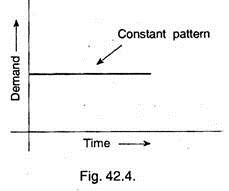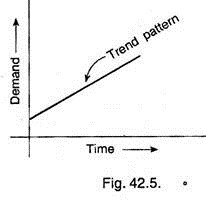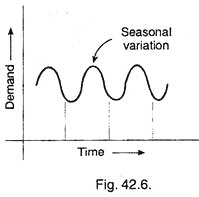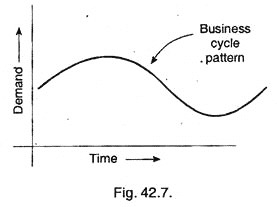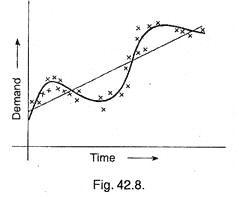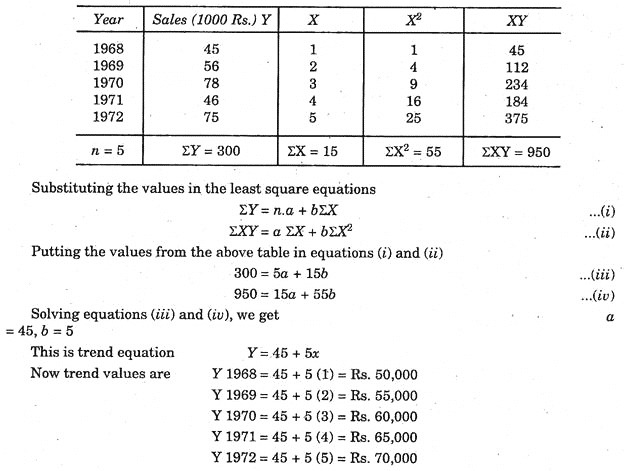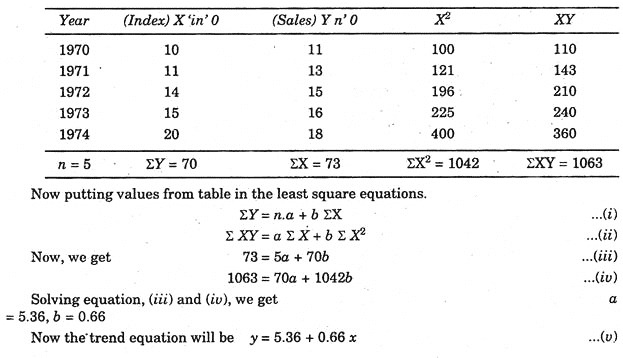After reading this article you will learn about:- 1. Meaning of Sales Forecasting 2. Importance of Sales Forecasting 3. Factors Considered 4. Types 5. Methods 6. Elements 7. Procedure 8. Selection 9. Uses 10. Statistical Data 11. Applications.
Meaning of Sales Forecasting:
Any forecast can be termed as an indicator of what is likely to happen in a specified future time frame in a particular field. Therefore, the sales forecast indicates as to how much of a particular product is likely to be sold in a specified future period in a specified market at specified price.
Accurate sales forecasting is essential for a business house to enable it to produce the required quantity at the right time. Further, it makes the arrangement in advance for raw materials, equipment’s, labour etc. Some firms manufacture on the order basis, but in general, firm produces the material in advance to meet the future demand.
Forecasting means estimation of quantity, type and quality of future work e.g. sales. For any manufacturing concern it is very necessary to assess the market trends sufficiently in advance. This is a commitment on the part of sales department and future planning of the entire concern depends on this forecast.
The management of a firm is required to prepare its forecast of share of the market that it can hope to capture over the period of forecasting. In other words, sales forecast is an estimate of the sales potential of the firm in future. All plans are based on the sales forecasts.
This forecast helps the management in determining as to how much revenue can be expected to be realised, how much to manufacture, and what shall be the requirement of men, machine and money.
Thus we can define sales forecasting as, estimation of type, quantity and quality of future sales. Goal for the sales department is decided on the basis of this forecast and these forecasts also help in planning future development of the concern. The sales forecast forms a basis for production targets.
From above, looking to its importance, it is essential that sales forecast must be accurate, simple, easy to understand and economical.
Thus we can say that a sales forecast is an estimate of the amount of sales for a specified future period under a proposed marketing plan or programme. Sales forecast can also been defined as, an estimate of sales in terms of money or physical units for a specified future period under a proposed marketing plan or programme and under an assumed set of economic and other forces outside the unit for which the forecast is made.
Importance of Sales Forecasting:
Sales forecasting is a very important function for a manufacturing concern, since it is useful in following ways:
(i) It helps to determine production volumes considering availability of facilities, like equipment, capital, manpower, space etc.
(ii) It forms a basis of sales budget, production budget natural budget etc.
(iii) It helps in taking decision about the plant expansion and changes in production mix or should it divert its resource for manufacturing other products.
(iv) It helps in deciding policies.
(v) It facilitates in deciding the extent of advertising etc.
(vi) The sales forecast is a commitment on the part of the sales department and it must be achieved during the given period.
(vii) Sales forecast helps in preparing production and purchasing schedules.
(viii) Accurate sales forecasting is a very good aid for the purpose of decision making.
(ix) It helps in guiding marketing, production and other business activities for achieving these targets.
Factors Considered for Sales Forecasting:
Following factors should be considered while making the sales forecast:
1. Competition:
To assess demand, it is the main factor to know about the existing and new competitors and their future programme, quality of their product, sales of their product. Opinion of the customers about the products of other competitors with reference to the product manufactured by the firm must also be considered.
2. Changes in Technology:
With the advancement of technology, new products are coming in the market and the taste and the likings of the consumer’s changes with the advancement and change of technology.
3. Government Action:
When the government produces or purchases then depending upon the government policy and rules, the sales of the products are also affected.
4. Factors Related to the Concern Itself:
These factors are related to the change in the capacity of the plant, change in price due to the change in expenditure, change in product mix etc.
Accurate sales forecasting is essential for a business house to enable it to produce the required quantity at the right time. Further, it makes the arrangement in advance for raw materials, equipment’s, labour etc. Many firms manufacture on the order basis, but in general, every firm produces the material in advance to meet the future demand.
Types of Sales Forecasting:
There are two types of forecasting:
1. Short-term forecasting and
2. Long-term forecasting.
1. Short-Term Forecasting:
This type of forecasting can be defined when it covers a period of three months, six months or one year. Generally, the last one is most preferred. The period is dependent upon the nature of business. If the demand fluctuates from one month to another, forecasting may be done only for a short period.
Purpose of Short-Term Forecasting:
1. To adopt suitable production policy so that the problem of overproduction and short supply of raw material, machines etc. can be avoided.
2. To reduce the cost of raw materials, machinery etc.
3. To have proper control of inventory.
4. To set the sales targets.
5. To have proper controls.
6. To arrange the financial requirements in advance to meet the demand.
2. Long-Term Forecasting:
The forecasting that covers a period of 5, 10 and even 20 years. The period here also depends upon the nature of business, but beyond 12 years, the future is assumed as uncertain. But in many industries like ship-building, petroleum refinery, paper making industries, a long term forecasting is needed as the total investment cost of equipment is quite high.
Purpose of Long-Term Forecasting:
1. To plan for the new unit of production or expansion of existing unit to meet the demand.
2. To plan the long-term financial requirements.
3. To train the personnel so that man-power requirement can be met in future.
Methods Used for Sales Forecasting:
Following are the methods generally employed for sales forecasting:
1. Survey of Buyers’ Views:
This is direct method for making forecasting for short-term, in which the customers are asked what they are thinking to buy in near future say, in the coming year. In this method all the burden is with consumers, which may misjudge or mislead or may be uncertain about the quantity to be purchased by them in near future.
The disadvantages of this method are as follows:
1. Consumer’s buying intentions are irregular.
2. When consumers have to select between different alternatives, they are unable to foresee their choices.
3. Buyers may be anxious for purchasing the products but due to certain limitations they may be unable to purchase them.
2. Collective Opinion or Sales Force Polling:
In this method forecasting depends upon the salesman’s estimation for their respective areas, because the sales-man are closest to the customers, hence can estimate more properly about the consumers’ reaction about the product and their future requirements.
All the estimates of salesmen are consolidated to know the total estimate of the sales. This final estimate then goes through severs checking to avoid undue imagination which is done many times by the salesmen.
The revised estimates are then again examined in the light of factors like expected change in design, change in prices, advertisements, competition, purchasing power of local people, employment, population etc.
This method of collective opinion takes advantages of collective wisdom of salesmen, senior executives like production manager, sales manager, marketing officials and managers.
Advantages:
1. This method is simple and requires no statistical technique.
2. The forecasts are based on the knowledge of salesmen, who are directly responsible for the sales.
3. In practice, this method is much useful in the case of new products.
Disadvantages:
1. This method is useful only for short-term forecasting, i.e. maximum for one year.
2. As the forecasting is dependent upon the salesmen’s estimation and if sales quotas are fixed then they, in general under-estimate the forecast.
3. As Salesmen have no knowledge about the economic changes, the estimate by them are not so correct many times.
4. As the estimation is full time job, the quality to look into the future must be with the salesmen.
3. Trend Projections:
Well-established firms which have considerable data on sales, these data are arranged in a chronological order, known as ‘time series’. Thus ‘time series’ are analysed before making the forecasts.
There is a common method known as ‘Project the trend’. In this method the trend line is projected by some statistical method, generally, by least square method.
The time series forecasts are the demand characteristics over time. These time series data are analysed for forecasting future activity levels. Time series data refer to a set of values of some variables measured at the equally spaced time intervals such as monthly production levels, demands in the market etc.
The demands have following patterns:
(i) Constant Pattern:
Refer Fig. 42.4. In this pattern demand remains constant throughout the period.
(ii) Trend Pattern:
It refers to the long-term growth or decline in the average level of demand, as shown in Fig. 42.5.
(iii) Seasonal Pattern:
It refers to the annually repetitive demand fluctuation that may be caused by weather, tradition or other factors. (Refer Fig. 42.6).
(iv) Cycle Pattern:
Business cycle refers to the large deviation to actual demand values due to complex environmental influences. Refer Fig. 42.7. These are similar to the seasonable components except that seasonality occurs at regular intervals and is of constant durations whereas it varies in both time and duration of occurrence.
(v) Combination of Different Pattern:
In long term forecast (more than 2 years) seasonal factors are ignored and focus is given on trend component with a minor emphasis on business cycle. In medium term forecasts (few months to 2 years), the trend factor becomes less important and the seasonal and random factors are given more importance.
For short duration (one week to 3 months) main concern is random fluctuations. Generally when a business concern is in operation, combination of trend and seasonal variations are given importance. Such a pattern is shown in Fig. 42.8.
Example 1:
The annual sales of a company are as follows:
By the method of least squares, find the trend values for each of the five years. Also estimate the annual sales for 1973.
Solution:
The forecasting for the year 1973 will be
Y 1973 = 45 + 5 (6) = Rs.75,000
4. Economic Indicators:
In this method the forecasting is dependent upon certain economic indicators, which are generally published by Central Statistical Organization under the national income estimates.
Some of these indicators are:
1. Personal income for the demand of consumers’ goods.
2. Agricultural income for the demand of agricultural inputs, implements etc.
3. Construction contracts sanctioned for demand of building materials.
4. Registration of automobiles for the demand of accessories, petrol’s etc.
The forecasting is done with the help of least square equations. The examples illustrated below will give an idea, how the forecasting is done. This method has some limitations, likewise.
1. Appropriate economic indicator is difficult to find out.
2. For newer products, no past data are available.
Example 2:
Suppose a firm is manufacturing automobiles and finds a relationship between sale of automobile and the Index demand for cars.
The sales for the last five years are:
Find the relation between the demand index and sale of automobile. Further, make a forecast for the year 1975; supposing the demand index rise to 210. Use least square method.
Solution:
Thus equation (vi) is the relation between the demand Index and sales.
Forecasting for year 1975 with demand Index 210.
Y = 53.6 + 0.66 (210) = 192 automobiles.
Elements of a Good Sales Forecasting:
Following four elements are suggested for adopting a sales forecasting method:
1. Accuracy:
The previous method must be checked for want of accuracy by observing that the predictions made in past are accurate or not.
2. Simplicity:
The method must be simple and easily understandable. It should satisfy top management people.
3. Economy:
For an undertaking, cost is a main factor so the method adopted should consider the minimum cost.
4. Availability:
The technique must be able to produce meaningful results quickly. The technique which takes much time to produce useful information is of no use.
Procedure of Making a Sales Forecast:
1. State whether the forecasting is short-term or long term, its objectives, only for a single undertaking or for whole industry.
2. Select a good method of forecasting.
3. Select different variables which are affecting the forecasting.
4. Gather data for different variables.
5. Determine best possible relationship by some statistical method between different variables.
6. Make forecast and interpret the result.
Following points must be made clear before making a forecast:
1. Forecast must be made in terms of rupees of sale volume or in units.
2. Forecast must be made on annual basis and then further divided as requirement, i.e. by month-wise, week-wise, or so on the basis of previous year’s records.
3. Forecast for new product by month-wise, may be done either using other manufacturing concern’s data or by survey.
4. Forecast must be made in terms of product groups and broken for individual products, the division may be according to the sizes, brands, cables, colours etc. A typical example show how the product group is divided.
Example 3:
In the table, some previous year’s records are shown. Now if the forecast for product group for 1975 is Rs.150,000, then divide this product group and find the forecast for product Y.
Now the forecast can be broken under two conditions:
(i) According to trend, supposing the sales increase as per trend, then this year the percentage of sales of product X will be 26%.
(ii) According to average, the average of the percentage of the last three years is 22%.
Thus the forecast for product X according to trend is Rs.39,000 and according to average Rs.33,000 i.e. 26% and 22% of 1,50,000 respectively.
Following points must be considered before making forecast of a new product:
1. Treat the demand for the new product as of an existing old product.
2. Treat the new product as a replacement for some existing product.
3. Estimate demands by making inquiries from purchaser.
4. Offer the new products for sale in a sample market.
5. Survey the customers reactions via dealers.
Selection of a Forecast:
There are several guidelines for selecting a forecast from available forecasts, one of them is as follows:
1. Prefer those forecasts which have reasoning’s underlying forecast.
2. Prefer those forecasts which are prepared by qualified personnel, as the future is uncertain, he must tell his assumptions on which forecast is based.
3. Look into the previous year’s forecasts, surveys should be examined as to why the forecasts are right or wrong.
4. Use only those forecasts which are reliable. Prefer only those of the forecasts which are prepared using different techniques.
5. Reject that particular forecast in which forecaster injected himself too strongly as an individual into his forecast.
Uses of Sales Forecast:
The sales forecast are helpful for various divisions of a concern.
Some of such uses are given hereunder:
1. Product Planning:
From forecasts we find out which product is more profitable and which should be manufactured and which should be dropped.
2. Planning Expansions:
Long range forecasts can predict future demand trends, which will enable the planning for expansion of the concern.
3. Financial Planning:
Sales forecast permits an evaluation of expenses and income etc.
4. Inventory Control:
It facilitates better planning and control over the inventories.
5. Production Control:
It will help in better production control, i.e. better use of equipment’s, controls over-time of labour, better deliveries, better control over work-in-progress inventories.
6. Sales Planning:
It helps in finding out which territory needs more attention. Various sales programme can be reassessed looking to their achievements.
Statistical Data Helpful in Sales Forecasting:
(A) For assessing general economic conditions of the country:
1. Industrial Production Index:
This index is based on the physical output of the factories and mines.
2. Bank Debits:
This will give overall financial condition of the business.
3. Employment:
Increased employment anticipates growth in demand, while decline in employment anticipates decline in production.
(B) For Assessing Future Price Trends:
1. Money in Circulation:
Increase of money in circulation without corresponding increase in goods supply indicates prices will rise.
2. Crop Production:
It indicate the trend of prices for agricultural products.
3. Price Index:
It is a reliable indicators prepared by the government.
(C) For Assessing Purchasing Power of the Consumer:
1. Rate of Wages:
Wage rates, bonus etc., indicates worker’s purchasing power.
2. Disposal Income:
This shows the actual amount of money the consumer is left to spend.
Applications of Sales Forecast:
Sales forecast can be used for following purposes:
1. It helps the management to decide marketing strategies.
2. It helps in preparing the budget and for setting financial policies.
3. With reliable sales forecast it is possible to produce at an average rate so that plant capacity and man power is fully utilized during the entire period. Thus the forecasting enables to overcome seasonal variations.
4. It helps in material planning and avoids the evils of both the over-stocking and under stocking.
5. From forecasts we can find out which product is more profitable and which should be manufactured and which should be dropped.
6. Long range forecasts can predict future demand trends, which will enable the planning for expansion of the concern.
7. It helps in finding out which territory needs more attention. Various sales programmes can be reassessed looking to their achievements.
